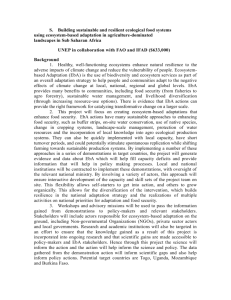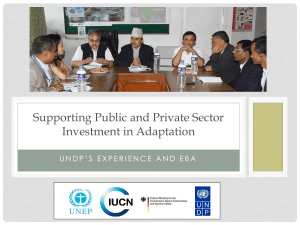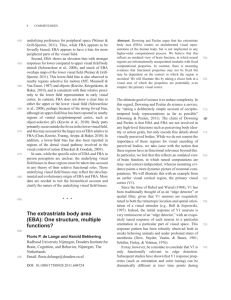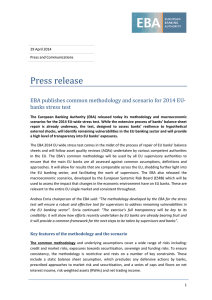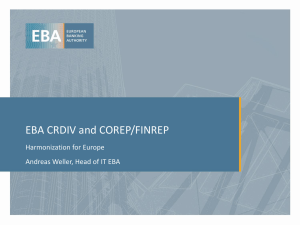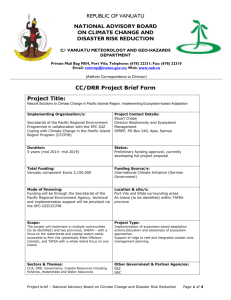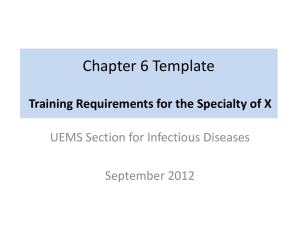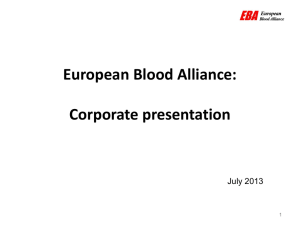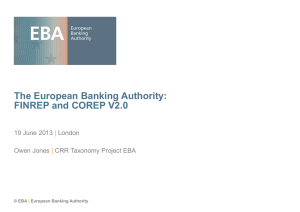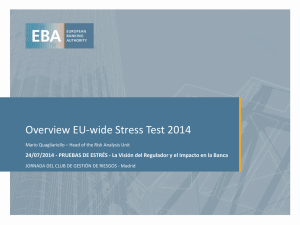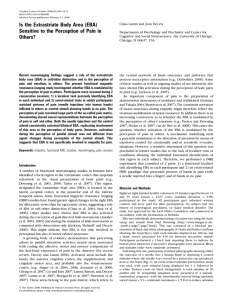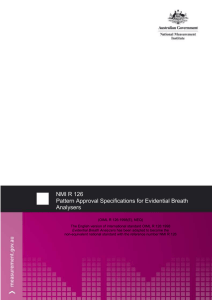Supporting Public and Private Sector Decision
advertisement
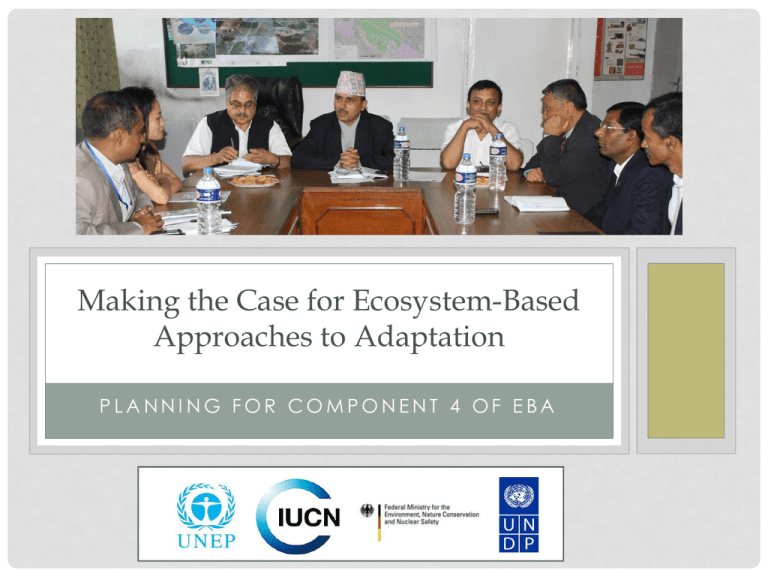
Making the Case for Ecosystem-Based Approaches to Adaptation PLANNING FOR COMPONENT 4 OF EBA EBA in Mountain Ecosystems Components Lead Agency 1. Development of methodologies and tools for EbA decision-making in mountain ecosystems 2. Application of methodologies and tools at ecosystem level UNEP 3. Implementation of EbA pilots at ecosystem level IUCN/UNDP 4. Development of business case for EbA at the national level UNDP UNEP Making the case for EBA What do we want to do? We want to make the case to government to: a. use EBA approaches as part of the suite of options to manage climate risk effectively in mountain regions b. enhance enabling environments for scalingup EBA more broadly as part of climate risk management strategies How can we do this? 1. Assess costs and benefits of EBA options in key sectors in mountain regions (including evidence from sites) 2. Produce policy papers that guide strategies and resource allocation in sectors 3. Make the case to government through steering committee 4. Develop and complete a Policy and Financing Framework for EBA scale-up beyond mountain regions – identify opportunities to intervene Experience from other areas of UNDP’s work 1. Catalyzing Adaptation Finance in developing countries 2. Costing the gap: Investment and Financial Flows 3. Capacity building: Training on cost–benefit analysis 4. Climate Change Public Expenditure Review 5. EBA: Making the case to government 1. Catalyzing adaptation finance in developing countries Catalyzing Adaptation Finance (a) (b) (c) Enhance the capacity of policy makers to identify appropriate mix of public instruments including public finance to catalyze larger private investments Create an enabling environment including national/sub-national/ sectoral policy frameworks, domestic technical expertize, financing channels, and administrative procedures Attract innovative finance to provide additional financial incentives UNDP-GEF Services to Catalyze Adaptation Finance (I) Assist Governments (e.g. through national adaptation plans) to identify priorities from perspective of: (a) preserving existing infrastructure, businesses and livelihoods; (b) new business opportunities (c) no regret options (II) to identify barriers to priority investments (III) identify risks generated by these barriers that prevent the requisite investment (IV) what are the de-risking instruments (V) What are source of finance to support de-risking strategy In support of inclusive and green growth, reduction of inequalities via Green, Low Emission Climate Resilient Development Private sector increasingly important The main drivers of private sector investment will be: • Preserving existing infrastructure, businesses and livelihoods (E.g. SMEs currently engaged in rural agri-businesses, climate resilient infrastructure) • Developing new businesses (E.g. business diversification such new microfinance/insurance products, off-farm employment in new markets, mobile phone operators and climate information dissemination) • No-regret investments (adaptation is an ancillary benefit) (E.g. coastal communities develop mangrove belts increase incomes and meet energy needs and protects shorelines from expected coastal hazards (storm surges, etc.) 2. Costing the gap: Investment and Financial Flows “Bottom-up” quantification of costs Country-level baseline and reference scenario costs for sectoral adaptation through to 2030 16 countries Bangladesh, Colombia, Costa Rica, Dominican Republic, Ecuador, Gambia, Honduras, Liberia, Namibia, Niger, Paraguay, Peru, Togo, Turkmenistan, Uruguay 39 I&FF assessments completed since 2008 Examples from Costa Rica Total cumulative sum of investments (2010-2030) in biodiversity sector, by investment type Annual incremental cost of investments (2010-2030) for biodiversity & water sectors Water Biodiversity Baseline Adaptation scenario Difference IFF Results: Headline numbers in EBA countries Peru: • ecosystem management costs for agriculture in San Martín: US$ 65.8 million, and Junín: US$ 75.4 million • Ecosystem-based integrated water resource management US$ 638.1 million Nepal: • capacity building process • National issues papers – Glacial Lake Outburst Flooding 3. Capacity building: Training on Cost Benefit Analysis UNDP/ADAPT Asia-Pacific ECCA Programme • "Assessing Costs and Benefits of Adaptation: Methods and Data” • 2-year Capacity Building Programme on the Economics of Climate Change Adaptation, Funded by USAID • Bangladesh, Cambodia, Lao PDR, Indonesia, Malaysia, Maldives, Mongolia, Nepal, Philippines, Sri Lanka, Thailand, and Vietnam • Water and agriculture adaptation projects used as case studies for the application of cost-benefit analysis • Mentors assigned to provide technical support to country teams on data collection, project and sectoral evaluations Nepal Case Studies • Water project selected as case study: Kalleritar Irrigation System, funded by Asian Development Bank (during rehabilitation stage) and led by Government of Nepal • Agriculture project: Cost Benefit analysis of Paddy production in the Community Managed Irrigated Agriculture Sector Project- Dhading District • The team aims to undertake a nation-wide (250 -300 observations) primary data collection for agriculture sectoral analysis • The team will conduct secondary water collection in the Khani Khola watershed for the water sector analysis 4. Climate change public expenditure review Climate Public Expenditure Review Methodology • Cross-government Steering group led by Finance and Planning Ministries • Public Expenditure Reviews (of World Bank) • Sectoral focus: Local government (Bangladesh, Nepal), Transport (Cambodia and Samoa), Irrigation (Thailand) • Review of policies and institutions including perverse incentives • Quantity and quality of climate expenditure: • Review whole budget • Expert assessment of climate “relevance” • Positive and negative expenditure • Action plans for implementation – • incorporation in budget framework • large development projects, • disaster risk institutions Complementing Existing Initiatives In Nepal • Pilot Programme for Climate Resilience – Climate Investment Fund • Hariyo Ban programme – USAID • Multi Stakeholder Forestry Programme • Community Based Flood and Glacial Lake Outburst (GLOF) Risk Reduction – LDCF-funded, UNDP-managed • Implementation of NAPA through ecosystem management – LDCF-funded, UNEP-managed • UNEP/UNDP Poverty and Environment Initiative • PEI – Climate Change Public Expenditure and Policy Review • PEI / UN Habitat Urban EBA research in Asian cities Complementing Existing Initiatives In Peru • National and Regional Climate Change Strategies • Regional Participatory Development Plans • Nor-Yauyos Cochas Reserve Management Plan • Payments for watershed services in Cañete River Basin • PRAA costs and benefits of adaptation to glacier retreat • USAID Glaciers to Coast and Arequipa Adaptation Project • High Andean micro-watersheds - UNDP, UNEP, FAO • UNDP TACC development & investment planning • UNDP Investment & Financial Flows: agriculture & water • IADB capacity building, mainstreaming, technical cooperation, micro-finance Complementing Existing Initiatives In Uganda • USAID-funded project implemented by IUCN and ACCESS on “Building a Resilience Framework to Support Climate Change Adaptation in the Mt Elgon Region” • GIZ-funded project with Ministry of Environment and Water Affairs to produce a “Uganda National Climate Change Draft Costed Implementation Strategy” • Part of process of developing the National Climate Change Policy • Includes Design Report on “possible Engineering Adaptation options” for floods, water availability • Ongoing process by Climate Change Unit, Permanent Secretaries’ Forum, multi-stakeholder Technical Working Group • Link through National Climate Change Policy Committee which coopted project partners and German Embassy rep for EBA steering committee Possible Approach To Component 4 Phase 1: Preparation Recruit consultants Brief consultants Phase 2: Analysis Analysis of opportunities Sectoral cost benefit analyses Phase 3: Intervention Preparation of policy papers Policy& finance processes Phase 4: Outreach Capacity devt / training Making the case Nepal: Addressing Gaps To Complement Other Initiatives 1. Make the sectoral case on use of EBA as part of an integrated suite of approaches to adaptation – cost benefit analysis through selected case studies from Panchase and other mountain regions: • • • • Forestry Agriculture Water Tourism 2. Technical training for four sectors on implementation of EBA and hybrid approaches • • • • Methods and case studies Technical specifications Results and evidence Cost-effectiveness Peru: Analysis of Needs and Opportunities • Need for tools to help government adapt existing policies and finance mechanisms to incorporate EBA • Opportunities in public investment to feed into current processes (PACC, IPAC, Green Investment) to adjust for additional demands of addressing climate variability • Need to broaden existing typologies of public investment to incorporate EBA-type interventions - including guidelines, justification for them, and evaluation criteria for proposed interventions • Examples of interventions are EBA approaches to water resource management in high altitude pastures, or managing water levels in glacial lakes at risk of flooding • There is also a need to explore how ongoing operating costs of EBA can be financed (in addition to capital investment) Analysis of Needs and Opportunities contd • Detailed costing of all potential EBA work / quantification of an EBA finance "gap" would not be likely to be used by government • More useful is quantification of benefits in relation to costs so that the potential rate of return on state investment can be calculated • And comparative cost benefit analyses of nature-based (green) vs engineered (grey) options for mountain ecosystems where feasible • Where an engineered alternative does not exist, establishing unit costs / cost coefficients is still useful, as well as analysing benefits • Benefits analysed should include the full range, with an emphasis on socio-economic benefits that tie in with rural development objectives • Van use data and evidence from pilot site in Nor-Yauyos Cochas Reserve, incorporating local knowledge, and data from other cases • Selected private sector role-players (e.g. hydroelectric, mining) may also be able to use our tools to guide corporate social investment Potential Focus for Component 4 in Peru • Develop a toolkit together with and for use by the Peruvian Ministry of Economy and Finance, providing a typology and guidelines for public investment in EBA • Identify several investment types for EBA to vulnerabilities in mountain ecosystems • For each type, develop a set of products: • • • • • Technical guidelines on intervention (and alternative where relevant) Case study from EBA Component 3 / other work in Peru / elsewhere Cost-benefit analysis (and alternative where relevant) Presentation on outcomes for key role-players Training module with material and presentations Possible timeline for work on Component 4 Phase 1: Preparation Q3-Q4 2013 Recruit consultants Brief consultants Phase 2: Analysis Q1-Q3 2014 Analysis of opportunities Sectoral cost benefit analyses Phase 3: Intervention Q4 2014 – Q1 2015 Preparation of policy papers Policy& finance processes Phase 4: Outreach Q2-Q4 2015 Capacity devt / training Making the case Inputs from countries on needs and opportunities
